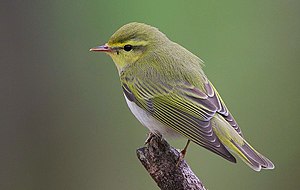VariousPasseriformes(perching birds) arecommonlyreferred to aswarblers.They are not necessarily closely related to one another, but share some characteristics, such as being fairly small, vocal, andinsectivorous.

Sylvioid warblers
editThese are somewhat more closely related to each other than to other warblers. They belong to asuperfamilyalso containingOld World babblers,bulbuls,etc.
- "Old World warblers",formerly all in family Sylviidae
- Leaf warblers,now in familyPhylloscopidae
- Typicalbush warblers,now in familyCettiidae
- Grass warblersandmegalurid bush-warblers,now in familyLocustellidae
- Marshandtree warblers,now in familyAcrocephalidae
- True warblersorsylviid warblers,remaining in familySylviidaeor moved into theTimaliidae
- Cisticolid warblers,familyCisticolidae
- Malagasy warblers,the newly assembled family Bernieridae
Passeroid warblers
editThe two families ofAmericanwarblers are part of another superfamily, which unites them withsparrows,buntings,finches,etc.
- Olive warbler,monotypicfamily Peucedramidae
- New World warblers,family Parulidae
Other
edit- Tit-warblersor flycatcher-tits, familyStenostiridae
These are closely related to thetitmice and chickadees
- Australasian warblers,familyAcanthizidae
These are the most distinct group of warblers. They are not closely related at all to the others, but rather to thehoneyeatersandfairy-wrens.
- Hawaiian honeycreeper—warbler-niched-(adaptive radiation), genusH. virens–common amakihi.[1](See:List of adaptive radiated honeycreepers)
References
edit- Wilson, Eisner, Briggs, Dickerson, Metzenberg, O'Brien, Susman, & Boggs.Life on Earth,Edward O. Wilson,Thomas Eisner,Winslow R. Briggs, Richard E. Dickerson, Robert L. Metzenberg, Richard D. O'Brien, Millard Susman, William E. Boggs, c 1973, Sinauer Associates, Inc., Publisher, Stamford, Connecticut. (hardcover,ISBN0-87893-934-2)